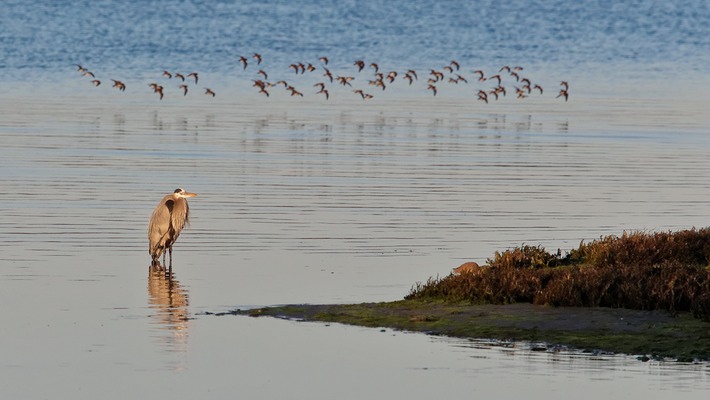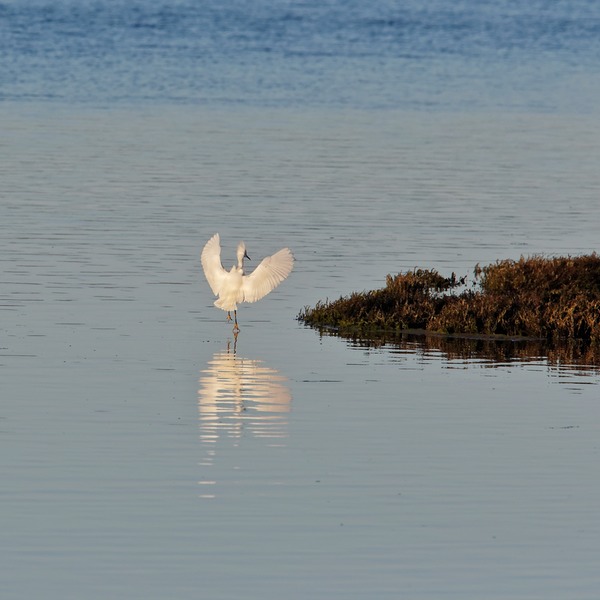- Time of year: Spring, Summer, Fall, and Winter. Summer tends to have fog roll in, changing the mood of the photographic elements. Winter can be a bit breezy, making for amusing bird-in-flight photography.
- Time of day: Sunrise thru Sunset, with the extremes providing spectacular light on the bay.
- Time of Tide: Ebb and flood tides. Both provide feeding action for the locals.

Fall thru early Winter are a good time for scouting wildlife. In late October, every morning from just before sunrise to an hour and change later provide some type of interesting interaction between the elements. Be it the sudden arrival of a fleet of Brown Pelicans diving for baitfish - an event that can last tens of minutes - to a very curious juvenile Snowy Egret that hams it up in front of a 100-400mm / 1.4x lens on several occasions - events that may last upwards of thirty minutes.
The Brown Pelicans, if in town, generally flock into the bay at flood tide, following the schools of fish that get caught on the incoming currents. The diving behavior starts with a few, then more arrive, and pretty soon there is a mass of pelicans diving into the bay. If the feeding frenzy is boisterous enough, other birds will join in, including the local Peregrine Falcon. If there is little in the way of mass feeding, there will generally be a few pelicans hover gliding ground effect style across the bay, nosing into the water to catch their meal, flipping over backwards in a manner undignified, yet photogenic.

Juvenile Snowy Egret CF7918 was a pleasure to photograph. I was fortunate to find a Snowy Egret at that age where everything is interesting and amazing, has not quite realized that he is different from the Gulls he hangs out with, and does not know how to land in the water. Walking around in water, that was fine. Landing? No way. Quite the show to watch him fly up from the water where he was investigating the world, then swoop down to make a water landing elsewhere, only to swoop back up, like an acrobatic kite avoiding liquid uncertainty. Eventually he would tire and land on shore, to then walk back into the water, keeping up with his investigations. A very odd duck, for a Snowy Egret.

At sunset one day I found CF7918 playing on the waters' edge, only to take off and come in for a wings-wide landing in the pine tree above me. There he spent some time watching me watching him, while he checked out the interesting newness of what it was to be in a pine tree. When he had finished scouting and determined there was nothing to eat, he quietly walked to the end of a branch, opened his wings, and fell downward to take flight like a diver performing at a circus. I found him again out at play one morning, readying for the sunrise and start of another wonderful Morro Bay day. This time he was very close, and again did not mind the 100-400 / 1.4x lens pointing at him. Watching me watching him, he came across a bug that drew his interest, a fly with a buzz - just another curiosity in the world.

There was the family of mule deer that came to Sweet Springs Nature Preserve to check out the water and morning shore birds. Mom, two kids, and Dad. One kid was a mommas' boy, another the carefree daughter who was determined to do her own thing, until Dad decided to follow the other two back into the brush and she decided it was too scary alone.

The local Peregrine Falcon taking her morning seat in the trees above the Baywood pier. Ever diligent for prey, she performs her morning ritual of monitoring, preening, moving from tree to tree, keeping an eye on the world. One year she had a Thanksgiving dinner that couldn't be beat when a school of baitfish made their way to the Baywood pier area, joining in on the morning dive & catch fun led by the Brown Pelicans and others. Not being the standard behavior of a Peregrine, she was pretty adept at the dive/catch/fly maneuver - until she was several hundred feet back in the air, drenched, with a fish in her claws. An amazing sight is a dripping Peregrine realizing she is soaked, shaking off the water mid-flight, free-falling half of the height she had climbed, then catching herself, all the while being chased by greedy Gulls, and not dropping her prize.

The owl families living in Sweet Springs Nature Preserve - always fun to find the babies as they are quite suspicious about the goings-on around them. Sometimes you find Dad. Sometimes you find Mom. Sometimes you find the chicks. Most of the time you can't find any of them, because that is the beauty of the whole thing.

I found Snowy Egret CF7918 again a few months later while testing the Canon 400mm DO lens as a comparison to the trusty 100-400. This time he was hanging out with Mr. Cranky Pants, a local Great Blue Heron. CF7918 was walking the water, looking for tasty bits to eat while the sun was rising. Once Mr. Cranky Pants had enough of that sunrise warmness, he took off like a Great Blue Heron does, circled around and flew off to his roost high in a neighboring pine tree.

It was then that CF7918 decided to hang out where his morning mentor had been standing, and made the perfect ballet dancer's landing onto that now simple-to-land-on mass of liquid. As for the 400mm DO, it is a nice lens, but not as versatile as, say, Canon's 200-400mm. Not as versatile or light as the trusty 100-400 either, which comes in a bit lighter than the DO and two thirds lighter than Canon's 200-400 telephoto King.
…plants and birds and rocks and things.